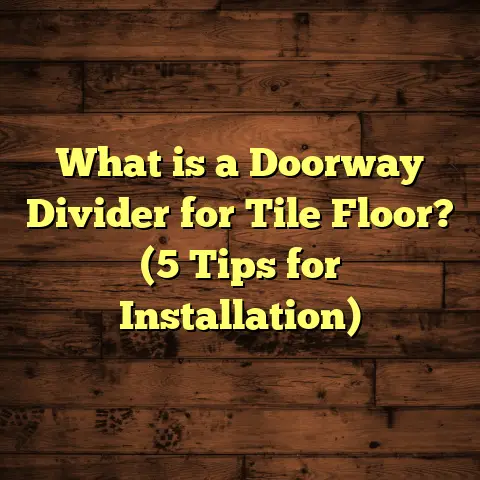What is a Vapor Barrier in Crawl Spaces? (5 Benefits Revealed!)
Have you ever walked into a crawl space beneath a house and been hit by that unmistakable damp, musty smell? Maybe you’ve noticed the floors above feel colder or more humid than you’d expect, or worse, you’ve spotted mold or wood damage when inspecting your home’s foundation. I’ve encountered these problems countless times in my years working as a flooring contractor and foundation specialist. And one thing I’ve learned early on is that moisture under the house is often the root cause of many issues.
One of the most effective ways to control that moisture is by installing a vapor barrier in your crawl space. But what exactly is a vapor barrier? And why should you care? Let me walk you through everything I know—from what a vapor barrier is, to the top benefits I’ve seen firsthand, to practical tips and stats that will help you protect your home and improve indoor comfort.
What Is a Vapor Barrier in Crawl Spaces?
Simply put, a vapor barrier is a material designed to prevent moisture from traveling through surfaces like soil or concrete into the crawl space air under your home. The crawl space is the area between the ground and the first floor of your house—often just a few feet high, where plumbing pipes, electrical wiring, and HVAC ducts run.
Because crawl spaces are right above the soil, they’re naturally exposed to ground moisture. Soil constantly releases water vapor which can seep into these spaces if left unchecked. A vapor barrier typically consists of thick polyethylene plastic sheets—anywhere from 6-mil to 20-mil thick—laid over the dirt floor inside the crawl space. This plastic sheet acts like a shield that blocks moisture from evaporating out of the soil and into your home’s foundation area.
Without this protective layer, moisture rises unchecked, causing humidity to spike inside the crawl space. This leads to all sorts of trouble: wood rot, mold growth, insulation damage, musty odors, and even compromised air quality inside your living spaces.
Why Moisture Control Matters in Crawl Spaces
I remember inspecting an older home once where the floor joists were visibly rotting and covered with mold. The owners had no idea why their floors felt spongy or why their allergies worsened every spring. When I peeked into their crawl space, it was muddy and damp with no vapor barrier at all. Soil moisture was freely evaporating into the air beneath their home.
After installing a high-quality vapor barrier and sealing some vents, moisture levels dropped dramatically. Over time, the wood dried out and stabilized. The homeowners reported fewer allergy symptoms and a noticeable improvement in comfort upstairs.
This kind of experience taught me how much difference controlling ground moisture can make—not just for structural health but for overall home livability.
How Moisture Enters Crawl Spaces
You might be wondering: where does this moisture come from in the first place? Let me break it down.
- Rainfall and groundwater: Water seeps into soil after rain or snowmelt. Depending on your region’s climate and soil type, moisture content underground can be quite high.
- Soil evaporation: Moist soil naturally releases water vapor upwards. It’s a slow but continuous process.
- Condensation: Warm humid air entering a cooler crawl space can cause water to condense on surfaces.
- Leaks: Plumbing leaks or poor drainage around the foundation add extra moisture.
When moist air accumulates in crawl spaces, it increases relative humidity (RH). RH above 60% creates ideal conditions for mold growth and wood decay. In some cases, I’ve measured RH levels in crawl spaces over 90% when no vapor barrier or ventilation control exists.
Five Benefits I’ve Seen Vapor Barriers Provide
Let me share five key benefits that make vapor barriers one of my top recommendations when working on crawl space or flooring projects.
1. Controls Moisture and Reduces Humidity
I can’t stress this enough: controlling moisture is mission number one.
Moisture control starts at its source—the soil. By covering the dirt floor with a vapor barrier, you block evaporation of water vapor into the crawl space air.
Data Insight:
Building Science Corporation reports that installing vapor barriers reduces moisture migration by over 90% compared to bare soil.
In my experience, installing a vapor barrier can reduce crawl space relative humidity from 80%+ down to around 50%, which greatly limits mold growth risks.
2. Protects Structural Components from Rot
Wood framing—floor joists, beams, subflooring—is vulnerable to prolonged moisture exposure. Wood fibers break down when wet over time, causing rot and structural weakening.
I recall one project where floor joists had visible rot due to crawl space moisture. The homeowner was worried about expensive repairs. After installing a 20-mil polyethylene vapor barrier along with improved drainage, moisture dropped significantly. Over several months, wood dried out and stopped deteriorating—saving thousands in potential replacement costs.
3. Improves Indoor Air Quality
Did you know that air from your crawl space can enter your living area? Through floor vents or cracks in subflooring, air carrying mold spores or musty odors can circulate indoors.
By reducing moisture in the crawl space with a vapor barrier, you minimize mold growth chances. This results in fresher air inside your home.
The Environmental Protection Agency (EPA) notes that homes with sealed crawl spaces have significantly lower airborne mold spore counts than those without.
4. Increases Energy Efficiency
High humidity makes heating and cooling systems work harder because moist air feels warmer in summer and cooler in winter.
When I install vapor barriers combined with insulation upgrades, homeowners often report their HVAC systems cycling less frequently. Less energy use = lower utility bills.
Oak Ridge National Laboratory research shows homes with encapsulated crawl spaces (vapor barrier + sealing) reduce energy consumption by about 10-15%.
5. Prevents Pest Infestations
Moist environments attract pests like termites, carpenter ants, rodents, and insects—all eager to nest where conditions are damp and dark.
By cutting off moisture sources with vapor barriers, you make your crawl space less hospitable to these critters.
One client had ongoing termite issues that disappeared after we installed a professional-grade vapor barrier system combined with sealing entry points.
Choosing the Right Vapor Barrier: What Works Best?
Over years of experience and following industry guidelines, here’s what I recommend when selecting and installing vapor barriers:
- Thickness matters: Use at least 6-mil thick polyethylene for basic protection in dry climates. For better durability—especially in humid areas—go for 12- to 20-mil thickness.
- Full coverage: Cover all exposed soil completely. Extend the plastic up crawl space walls about 6-12 inches for better sealing.
- Seam overlap & taping: Overlap seams by a minimum of 12 inches and tape them with waterproof vapor barrier tape.
- Repair promptly: Check periodically for tears or holes caused by animals or debris; patch immediately.
- Professional installation: If possible, hire a professional who knows how to lay the material flat without punctures or wrinkles.
Additional Moisture Control Tips That Work
Vapor barriers are powerful but work best as part of a broader strategy:
- Seal vents: Many older homes have vented crawl spaces meant to let air circulate—but this often brings humid outdoor air in. Sealing vents can stop this.
- Improve drainage: Ensure gutters divert rainwater well away from your foundation; grade soil slopes away from the house.
- Use dehumidifiers: In very humid regions or persistent problem areas, placing a dehumidifier helps keep RH low.
- Fix leaks: Plumbing leaks under houses add unwanted moisture fast—fix these immediately.
- Add insulation: Proper insulation on walls or floors above the vapor barrier helps maintain temperature control and reduces condensation risk.
My Personal Crawl Space Stories
One older house I worked on had what you might call a “DIY” vapor barrier job—thin plastic sheets roughly thrown down on dirt with no sealing or taping. It looked like an afterthought more than anything else. Naturally, it was ineffective: gaps allowed moisture through and animals tore holes in it over time.
I removed all old plastic sheets and debris first before installing a professional-grade 20-mil polyethylene sheet taped tightly at seams and sealed along foundation walls. We also added rigid foam insulation on walls above the barrier.
The homeowner called me six months later saying the musty smells were gone and there was noticeably less dampness during rainy season. Even heating bills dropped slightly that winter.
Another memorable case involved a family battling allergy symptoms linked to mold spores traced back to their crawl space. After installing a full vapor barrier system combined with improved ventilation sealing, their symptoms improved dramatically within weeks.
Some Eye-Opening Data About Vapor Barriers
- Vapor barriers reduce soil moisture migration by over 90% compared to bare dirt floors (Building Science Corporation).
- Encapsulated crawl spaces (vapor barrier + sealing) reduce energy bills by 10-15% on average (Oak Ridge National Laboratory).
- Mold growth risk drops by more than half when relative humidity stays below 60%, achievable through proper vapor barriers (EPA).
- Homeowners report fewer pest problems when moisture is controlled under the house (Termite Prevention Studies).
How To Inspect Your Crawl Space for Vapor Barrier Needs
Not sure if your crawl space has an effective vapor barrier? Here’s what I look for during inspections:
- Is there plastic covering the dirt floor? If yes, what thickness? Does it look intact or torn?
- Are there gaps where soil shows through?
- Are seams overlapped and taped?
- Is plastic extended up walls or only laid flat on soil?
- Are vents sealed or open?
- Is there visible mold, wood rot, or pest signs?
- What’s the current humidity level? (I use a hygrometer for measurement.)
If you spot problems like torn plastic or no barrier at all, it’s time to plan an upgrade.
Installation Process – What to Expect
Here’s a quick overview of how I install vapor barriers during crawl space projects:
- Clear debris: Remove rocks, roots, trash, old plastic sheets.
- Level soil: Smooth out uneven spots; fix drainage if needed.
- Lay plastic sheets: Start at one corner; roll out sheets overlapping seams by at least 12 inches.
- Tape seams: Use specialized vapor barrier tape.
- Extend up walls: Secure with adhesive or anchors 6-12 inches up.
- Seal vents if applicable: Use foam board or spray foam insulation.
- Add insulation if specified: Rigid foam panels or spray foam along walls.
- Monitor for damage regularly: Check every 6 months or after storms.
Common Questions I Get About Vapor Barriers
Q: Can I install a vapor barrier myself?
A: Yes, if you’re comfortable working in tight spaces and follow installation guidelines carefully. But professional installation ensures proper sealing and reduces risk of damage during setup.
Q: How often should I replace my vapor barrier?
A: If installed correctly with durable material (like 20-mil polyethylene), it can last decades. Check annually for tears or damage caused by animals or shifting soil.
Q: Does sealing vents cause moisture buildup?
A: If done without proper vapor barriers or drainage improvements, yes. But when combined with full encapsulation (vapor barrier + sealed vents + dehumidification), it reduces humidity effectively.
Q: What about radon gas?
A: Vapor barriers also help reduce radon gas infiltration from soil into homes—a major health benefit especially in radon-prone areas.
Wrapping Up My Take
Protecting your home’s crawl space with a quality vapor barrier is one of those smart investments that pays off in multiple ways—structural health, indoor air quality, energy savings, and pest prevention.
If you haven’t checked your crawl space lately or suspect high humidity issues beneath your house, consider getting an inspection or consultation from a flooring or foundation specialist like me.
By stopping moisture at its source with a good vapor barrier and combining it with other improvements like sealing vents or adding dehumidifiers—you’ll save money long-term and enjoy a healthier home environment.
Got questions about your crawl space? I’m happy to chat more anytime!





